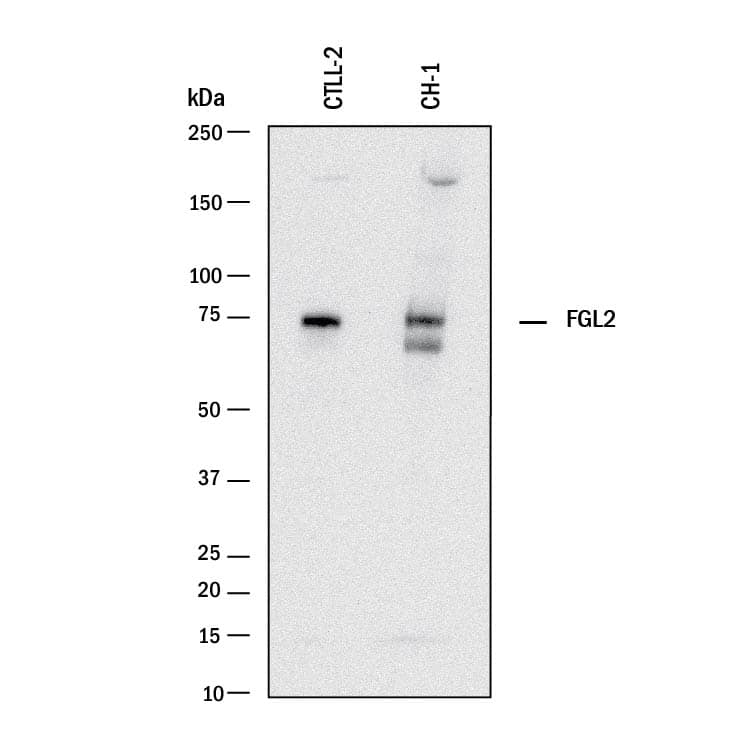Mouse FGL2 Antibody Summary
Val20-Pro432
Accession # P12804
Applications
Please Note: Optimal dilutions should be determined by each laboratory for each application. General Protocols are available in the Technical Information section on our website.
Scientific Data
 View Larger
View Larger
Detection of Mouse FGL2 by Western Blot. Western blot shows lysates of CTLL-2 mouse cytotoxic T cell line and CH-1 mouse B cell lymphoma cell line. PVDF membrane was probed with 2 µg/mL of Rat Anti-Mouse FGL2 Monoclonal Antibody (Catalog # MAB5257) followed by HRP-conjugated Anti-Rat IgG Secondary Antibody (Catalog # HAF005). A specific band was detected for FGL2 at approximately 70 kDa (as indicated). This experiment was conducted under reducing conditions and using Immunoblot Buffer Group 1.
Preparation and Storage
- 12 months from date of receipt, -20 to -70 °C as supplied.
- 1 month, 2 to 8 °C under sterile conditions after reconstitution.
- 6 months, -20 to -70 °C under sterile conditions after reconstitution.
Background: FGL2
FGL2 (fibrinogen-like protein 2), also called fibroleukin, is a 64-70 kDa secreted glycoprotein of the Fibrinogen-like superfamily. It has prothrombinase activity and also promotes T regulatory (Treg) activity (1-6). The mouse FGL2 gene encodes a 432 amino acid (aa) protein that contains a 19 aa signal sequence and a 413 aa mature sequence with a coiled-coil region and a fibronectin C-terminal homology domain or FRED (1, 2). A 260-280 aa FGL2 complex is thought to be a tetramer formed by covalent disulfide linkage of dimers that are asoociated via coiled-coil interactions (2, 3). Mature mouse FGL2 shares 91% aa identity with rat FGL2, and 77-80% aa identity with human, equine, porcine, bovine and canine FGL2. FGL2 appears to have two modes of action. One mode involves its prothrombinase activity, which requires calcium and acidic phospholipids (4). This mode is thought to be active during hepatitis viral infections when FGL2, produced by macrophages in response to IFN-gamma, induces hepatic apoptosis and fibrin deposition (7). In addition, FGL2 produced by endothelial cells in response to TNF-alpha within cardiac xenografts or allografts promotes coagulation during acute vascular rejection (7-9). A second mode of action involves soluble (not phospholipid-associated) FGL2 and is independent of prothrombinase activity (2). Soluble FGL2 is required for Treg function, and directly suppresses DC, T, and B cell immune reactivity; consequently, some FGL2-deficent mice develop autoimmune glomerulonephritis (5, 6). In vitro, soluble FGL2 can skew T cell polarization toward Th2 and inhibit proliferation of stimulated T cells and maturation of DC (6). In pregnancy, fetal trophoblast cells secrete FGL2. The immune suppressive mode of FGL2 may prevent early fetal loss; however, the procoagulant mode is thought to mediate infection-triggered abortion (10).
- Koyama, T. et al. (1987) Proc. Natl. Acad. Sci. USA 84:1609.
- Marazzi, S. et al. (1998) J. Immunol.161:138.
- Olson, G. E. et al. (2004) J. Biol. Chem. 279:51266.
- Chan, C. W. Y. et al. (2002) J. Immunol. 168:5170.
- Shalev, I. et al. (2008) J. Immunol.180:249.
- Chan, C. W. Y. et al. (2003) J. Immunol. 170:4036.
- Liu, M. et al. (2006) J. Immunol. 176:7028.
- Mendicino, M. et al. (2005) Circulation 112:248.
- Ning, Q. et al. (2005) J. Immunol. 174:7403.
- Clark, D. A. et al. (2004) Mol. Hum. Reprod. 10:99.
Product Datasheets
FAQs
No product specific FAQs exist for this product, however you may
View all Antibody FAQsReviews for Mouse FGL2 Antibody
There are currently no reviews for this product. Be the first to review Mouse FGL2 Antibody and earn rewards!
Have you used Mouse FGL2 Antibody?
Submit a review and receive an Amazon gift card.
$25/€18/£15/$25CAN/¥75 Yuan/¥2500 Yen for a review with an image
$10/€7/£6/$10 CAD/¥70 Yuan/¥1110 Yen for a review without an image

